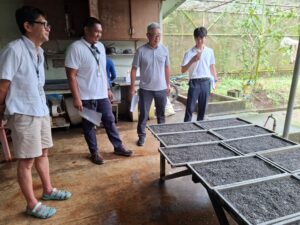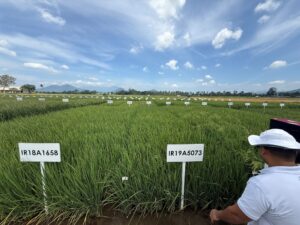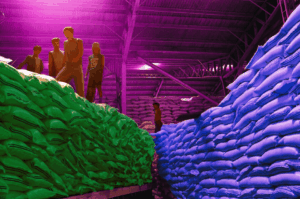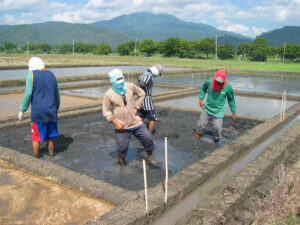
A long time ago, I was told, “Rice is to Asians what wine is to Europeans.” Wine is linked to Europe’s culture and cuisines as closely as rice is to Asia’s. Both rice and wine have myriad differences, but both are influenced by the environmental conditions under which the crop is grown. Each domesticated rice variety has qualities or traits that differentiate it from all others.
Grain shape
Rice grains can be round to long, straight, or curved. They can be short, medium, and long. A simple way to determine a rice variety’s length is to place a grain vertically beside grains of the same variety that are stacked on their sides. Then count the number of grain widths it takes to equal a grain’s length. This method works for unhulled, dehulled, and milled grains alike. When the length of the grain is no more than twice its width, it is short grained. Medium-grain rice is characterized by its length being between two and three times its width. And, long-grain rice has a length more than three times its width.
Parboiled rice
Parboiling is a method of partially cooking or gelatinizing the rice grain in its hull. For millers, gelatinization helps mend the grain’s cracks and fissures, and this improves the head rice or whole grain milling rate. Parboiling also transfers some of the nutrients from the outer germ layer, which is milled away, to make polished or white rice, into the endosperm. Milled parboiled rice tends to have a slight yellowish or tannish color. It also tends to take a little more water and cooking time. When cooked, parboiled rice is less sticky than its nonparboiled counterpart.
Milling quality
Rice quality also depends on milling. The milling process involves more than whitening or polishing—the mechanical removal of the pericarp from the endocarp. It begins with cleaning the paddy or harvested grain. This step may be followed by parboiling. Finally, the bran is milled from the grain. On average, with modern milling equipment, dehusking removes 20% of the paddy weight. An additional 10% is removed after milling, leaving 70% of the original weight. Modern rice mills also use sophisticated sorting machines that separate broken, chalky, speckled, and offcolor grains from the whole-grain head rice. A head rice output of 55% to 60% is considered good for modern equipment. In many areas around the world, rice is packaged and labeled according to grade, variety, percent of broken, and off-color grains present. White-rice quality increases with the number of times the grain passes through the mill and more starch layers are removed. This is an important aspect in making sake, a Japanese rice wine for which the liquor’s quality is judged on the number of milling cycles, among other factors.
Grain color
When milled, rice varieties produce white grain. Brown rice, also known as husked rice or cargo rice, is unmilled, has the bran attached to the grain, and is one of the healthiest forms of rice to eat. A majority of the vitamins in rice are in the bran and are lost with milling. Rice is milled because the oils in the bran readily oxidize, turn rancid, and impart an offflavor. Storing brown rice in the freezer will slow the process of rancidification. Rice bran oil is one of the healthiest plant oils and is high in heart-healthy tocopherols and tocotrienols, which are members of the vitamin E family. Rice bran oil extracted by some modern mills can be used in high-quality cooking oil, pharmaceuticals, and cosmetics. The bran is also used as animal feed and would be an excellent source of vitamins and fiber if the oil could be stabilized.
Rice starch
Amylose and amylopectin are the two basic starches that make up the rice endosperm. Amylose molecules are lightly branched chains of glucose monomers. Amylopectin, on the other hand, is made up of branching chains of the glucose molecule and is more easily digested than amylose. Long-grain rice typically has more amylose and is less sticky than medium- and short-grain rice, which tend to have progressively higher amylopectin content. Sticky or glutinous rice has no or a negligible amount of amylose. Rice is gluten-free and is considered hypoallergenic. Rice starch can be milled into flour or used in making everything from cosmetics to tablets. Rice starch granules are particularly good for making puddings, confections, and gravies, for which smoothness and texture are important. Cooked rice may also be enzymatically digested to produce rice syrup, or it can be fermented to produce alcohol. Sake is the most famous of the rice-based alcoholic beverages.
Enriched and fortified rice
Packaged rice may be labeled as either enriched or fortified. These represent two methods of adding back the vitamins and minerals that are lost in the milling process, which produces white or polished rice. Enriched rice is simply rice overcoated with vitamins and minerals. It is recommended not to wash enriched rice because this removes these vitamins and minerals. Fortified rice is made by blending vitamins and minerals with rice flour and extruding the dough through a granulator to create an artificial rice grain. These vitamins and minerals are then blended with the milled rice at a ratio of normally one or two fortified grains per hundred grains of milled rice. Fortified rice can be washed prior to cooking without a significant loss of vitamins and minerals.
Cooked rice
No single method of cooking rice works well for all varieties and cuisines. The optimum amounts of ingredients, temperature, and time allowed for cooking will vary with the variety, with the food being prepared, and with the equipment and method of cooking. Other ingredients, such as milk and cream, can be added before, during, or after cooking to add color, flavor, or texture. When I was a child, my mother cooked rice on the stove in a special rice pot with a double lip. A crust of brown, crispy, partially caramelized rice would frequently form at the bottom of the pot. This layer was called “koge” (pronounced “ko-gay”), Japanese for burned, and was a favored childhood delicacy. Unfortunately, with the modern rice cookers, koge rice is a thing of the past. Packaged precooked rice dishes, now in the market, need to be reheated only by placing the package in boiling water or the microwave.
The taste of rice
The taste of rice is the marriage of two senses: flavor and texture. A majority of rice varieties are nonaromatic and have subtle flavors that do not rely on aroma. Aromatic rice varieties, on the other hand, derive much of their distinctive flavor from the mixture of volatile chemicals. Cooked rice can run a wide gamut of textures. It can be waxy, firm, sticky, smooth, or creamy. At times, I’m asked what my favorite rice variety is. I always reply that I have no favorite; it depends upon what I am eating. Just as Basmati or Jasmine rice will not make good sushi or donburi, Nihonbare rice does not make the best Biryani rice, a popular Indian dish, or khao pad gai, a Thai rice dish. Each variety was developed for a consumer within a specific culture and cuisine. This being said, it gets down to personal preferences. Does this not hold true for wine as well?
Dr. Leeper is rice technology leader for RiceCo International, Inc.










Great post! We will be linking to this particularly great article on our website.
Keep up the good writing.